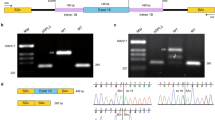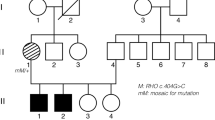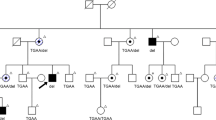Abstract
Incontinentia pigmenti (IP) is an X-linked dominant genodermatosis that is usually lethal in utero in males, though exceptionally they survive very rarely either with Klinefelter syndrome or a somatic mosaicism. We performed genomic analysis of five Japanese IP patients including a rare boy case, all of whom were definite cases with retinopathy. Four patients including the boy revealed the recurrent exon 4–10 deletion in the sole known causative gene IKBKG/NEMO, which was confirmed by various specific PCR techniques. The boy’s saliva DNA showed a mosaicism consisting of the deletion and intact alleles, but his blood DNA did not. Relative quantification analysis of the real-time PCR data by ∆∆CT method estimated the mosaicism ratio of the boy’s saliva as 45:55 (deletion:intact). A genomic analysis for the recurrent deletion at the nucleotide sequence level has been performed directly using patient’s DNA and it has been clarified that the breakpoints are within two MER67B repeats in the intron 3 and downstream of exon 10. This is the first report of the assay for the mosaicism ratio of a male IP case with a recurrent exon 4–10 deletion of IKBKG/NEMO and the sequencing analysis of the breakpoints of the recurrent deletion directly using patient’s sample.
This is a preview of subscription content, access via your institution
Access options
Subscribe to this journal
Receive 12 print issues and online access
$259.00 per year
only $21.58 per issue
Buy this article
- Purchase on Springer Link
- Instant access to full article PDF
Prices may be subject to local taxes which are calculated during checkout


Similar content being viewed by others
Change history
27 January 2021
A Correction to this paper has been published: https://doi.org/10.1038/s10038-021-00900-6
References
Landy SJ, Donnai D. Incontinentia pigmenti (Bloch-Sulzberger syndrome). J Med Genet. 1993;30:53–9.
Smahi A, Courtois G, Vabres P, Yamaoka S, Heuertz S, Munnich A, et al. Genomic rearrangement in NEMO impairs NF-κB activation and is a cause of incontinentia pigmenti. The International Incontinentia Pigmenti (IP) Consortium. Nature. 2000;405:466–72.
Parrish JE, Scheuerle AE, Lewis RA, Levy ML, Nelson DL. Selection against mutant alleles in blood leukocytes is a consistent feature in Incontinentia Pigmenti type 2. Hum Mol Genet. 1996;5:1777–83.
Woffendin H, Jakins T, Jouet M, Stewart H, Landy S, Haan E, et al. X-inactivation and marker studies in three families with incontinentia pigmenti: implications for counselling and gene localisation. Clin Genet. 1999;55:55–60.
Kunze J, Frenzel UH, Hüttig E, Grosse F-R, Wiedemann H-R. Klinefelter’s syndrome and incontinentia pigmenti Bloch-Sulzberger. Hum Genet. 1977;35:237–40.
Hull S, Arno G, Thomson P, Mutch S, Webster AR, Rai H, et al. Somatic mosaicism of a novel IKBKG mutation in a male patient with incontinentia pigmenti. Am J Med Genet A. 2015;167:1601–4.
Fusco F, Conte MI, Diociaiuti A, Bigoni S, Branda MF, Ferlini A, et al. Unusual father-to-daughter transmission of incontinentia pigmenti due to mosaicism in IP males. Pediatrics. 2017;140:e20162950.
Carney RG. Incontinentia pigmenti—a world statistical analysis. Arch Dermatol. 1976;112:535–42.
Goldberg MF, Custis PH. Retinal and other manifestations of incontinentia pigmenti (Bloch-Sulzberger syndrome). Ophthalmology. 1993;100:1645–54.
Fusco F, Pescatore A, Steffann J, Bonnefont JP, De Oliveira J, Lioi MB, et al. Clinical utility gene card: for incontinentia pigmenti. Eur J Hum Genet. 2019;27:1894–900.
Fusco F, Mercadante V, Miano MG, Ursini MV. Multiple regulatory regions and tissue-specific transcription initiation mediate the expression of NEMO/IKKγ gene. Gene. 2006;383:99–107.
Aradhya S, Bardaro T, Galgóczy P, Yamagata T, Esposito T, Patlan H, et al. Multiple pathogenic and benign genomic rearrangements occur at a 35 kb duplication involving the NEMO and LAGE2 genes. Hum Mol Genet. 2001;10:2557–67.
Bardaro T, Falco G, Sparago A, Mercadante V, Gean Molins E, Tarantino E, et al. Two cases of misinterpretation of molecular results in incontinentia pigmenti, and a PCR-based method to discriminate NEMO/IKKγ gene deletion. Hum Mutat. 2003;21:8–11.
Aradhya S, Woffendin H, Jakins T, Bardaro T, Esposito T, Smahi A, et al. A recurrent deletion in the ubiquitously expressed NEMO (IKK-γ) gene accounts for the vast majority of incontinentia pigmenti mutations. Hum Mol Genet. 2001;10:2171–9.
Döffinger R, Smahi A, Bessia C, Geissmann F, Feinberg J, Durandy A, et al. X-linked anhidrotic ectodermal dysplasia with immunodeficiency is caused by impaired NF-κB signaling. Nat Genet. 2001;27:277–85.
Garrod AE. Peculiar pigmentation of the skin in an infant. Trans Clin Soc Lond. 1906;39:216.
Berlin AL, Paller AS, Chan LS. Incontinentia pigmenti: a review and update on the molecular basis of pathophysiology. J Am Acad Dermatol. 2002;47:169–87.
Okita M, Nakanishi G, Fujimoto N, Shiomi M, Yamada T, Wataya-Kaneda M, et al. NEMO gene rearrangement (exon 4–10 deletion) and genotype-phenotype relationship in Japanese patients with incontinentia pigmenti and review of published work in Japanese patients. J Dermatol. 2013;40:272–6.
Nakao S, Nishina S, Tanaka S, Yoshida T, Yokoi T, Azuma N. Early laser photocoagulation for extensive retinal avascularity in infants with incontinentia pigmenti. Jpn J Ophthalmol. 2020. https://doi.org/10.1007/s10384-020-00768-7. In press.
Steffann J, Raclin V, Smahi A, Woffendin H, Munnich A, Kenwrick SJ, et al. A novel PCR approach for prenatal detection of the common NEMO rearrangement in incontinentia pigmenti. Prenat Diagn. 2004;24:384–8.
Rozen S, Skaletsky H. Primer3 on the WWW for general users and for biologist programmers. Methods Mol Biol. 2000;132:365–86.
Untergasser A, Nijveen H, Rao X, Bisseling T, Geurts R, Leunissen JA. Primer3Plus, an enhanced web interface to Primer3. Nucleic Acids Res. 2007;35:W71–4.
Zou CC, Zhao ZY. Clinical and molecular analysis of NF-κB essential modulator in Chinese incontinentia pigmenti patients. Int J Dermatol. 2007;46:1017–22.
Sakowicz A, Pietrucha T, Rybak-Krzyszkowska M, Huras H, Gach A, Sakowicz B, et al. Double hit of NEMO gene in preeclampsia. PLoS ONE. 2017;12:e0180065.
Riahi A, Chabouni-Bouhamed H, Kharrat M. Prevalence of BRCA1 and BRCA2 large genomic rearrangements in Tunisian high risk breast/ovarian cancer families: Implications for genetic testing. Cancer Genet. 2017;210:22–7.
Livak KJ, Schmittgen TD. Analysis of relative gene expression data using real-time quantitative PCR and the 2−∆∆CT method. Methods. 2001;25:402–8.
Acknowledgements
Grants from the Initiative on Rare and Undiagnosed Diseases from the Japan Agency for Medical Research and Development (AMED) (no. JP18ek0109301 to YH), the Grants-in-Aid for Scientific Research grants (KAKENHI) from the Japan Society for the Promotion of Science (JSPS) (no. JP17K11447 to YH), and the HUSM Grant-in-Aid 2019 of Hamamatsu University School of Medicine supported this study.
Author information
Authors and Affiliations
Corresponding author
Ethics declarations
Conflict of interest
The authors declare that they have no conflict of interest.
Ethical approval
The Institutional Review Board of the National Center for Child Health and Development and the Ethics Committee of Hamamatsu University School of Medicine approved this study, which adhered to the tenets of the Declaration of Helsinki.
Informed consent
The parents of the current patients provided written informed assent for their children and informed consent for themselves regarding ophthalmic examinations and treatment under general anesthesia, genetic analysis and publication of this report. A healthy person included in this study as control also provided written informed consent for DNA analysis and publication.
Additional information
Publisher’s note Springer Nature remains neutral with regard to jurisdictional claims in published maps and institutional affiliations.
Rights and permissions
About this article
Cite this article
Haque, M.N., Ohtsubo, M., Nishina, S. et al. Analysis of IKBKG/NEMO gene in five Japanese cases of incontinentia pigmenti with retinopathy: fine genomic assay of a rare male case with mosaicism. J Hum Genet 66, 205–214 (2021). https://doi.org/10.1038/s10038-020-00836-3
Received:
Revised:
Accepted:
Published:
Issue Date:
DOI: https://doi.org/10.1038/s10038-020-00836-3



